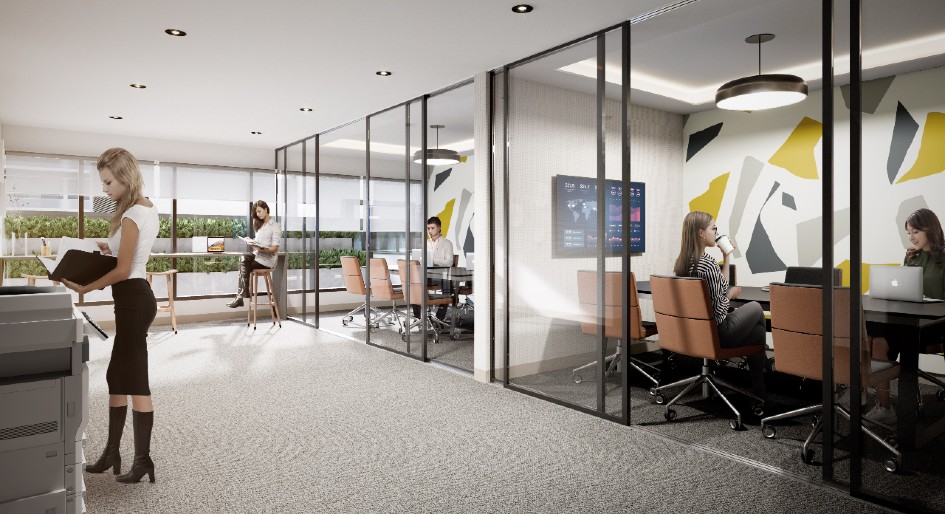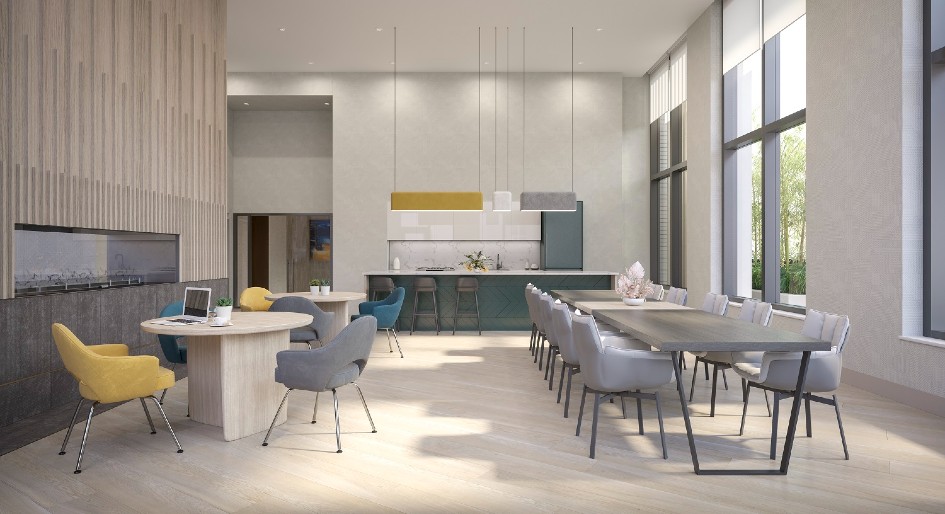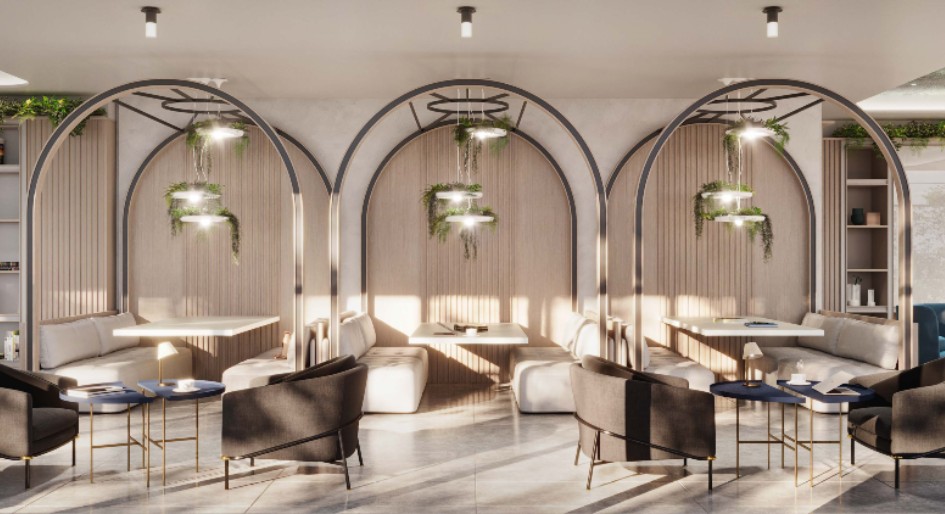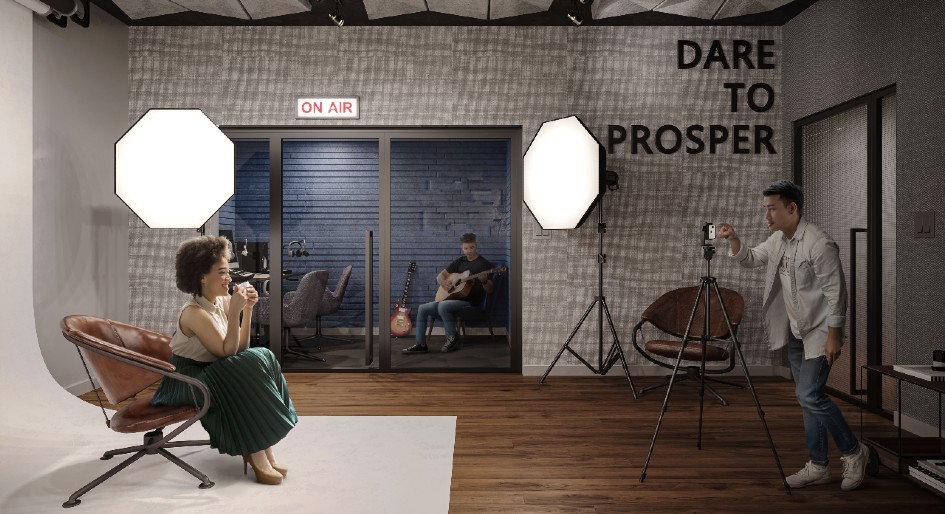A content studio with a green screen for producing videos and felt wall panels and acoustic ceiling tiles for recording the next great podcast has all the vibes of a cool, downtown office for creative types.
But there’s no morning commute to get there.
Arising from the undying love Canadians have for social networks, the studio is a new take on co-working space at the upcoming Verge Condos in Etobicoke, Ontario. And in an era where hybrid work arrangements might be here to stay, it’s just an elevator button away from home.
“The idea evolved from the understanding that not everyone has the same work-from-home needs, and people are creating content for both personal and professional uses,” says Kalliopi Karkas, assistant vice president, RioCan Living. “It’s something we know people need and will continue to need in the future.”
A new hybrid reality is starting to emerge. A survey in August from ADP Canada and Maru Public Opinion finds that 60 per cent of Canadian workers have gotten word on their employer’s return-to-work plans, and more than half were offered a hybrid or completely flexible schedule. Though co-working space predates the pandemic, it is taking on new resonance in the design world as remote work brings more precision and fresh perspectives to this amenity.
“One of the good things about COVID is that it solidified a purpose for these areas much more succinctly,” says Adèle Rankin, managing principal at B+H Architects. “Before, the amenity spaces in these towers would be larger, sprawling and more flexible spaces. Everybody was a little shy about assigning it very specific purposes.”
Observing people working at home has made it easier for designers to anticipate the diverse needs of multiple residents, with office buildings and hotels providing some inspiration.

Co-working spaces at M2M SQUARED come equipped with full-sized photocopiers and other office necessities. Photo courtesy of Aoyuan International.
Private and collective work areas, and Zoom rooms with clean backgrounds and no barking dogs, bring balance. “We recently just proposed a type of design that allows for a large communal-type space, with dividers that feel library-like,” says Rankin. “You’re there and you’re all together, but you can still maintain that privacy and safety and health.”
Of the projects she is working on, boardrooms are being chopped down into smaller meeting rooms that “cater to the everyday” rather than sporadic users, and co-working spaces are starting to look more domestic— a compelling extension of one’s home.

Intracorp’s Telford on the Walk in B.C. offers a domestic aesthetic close to home. Photo courtesy of CHIL Interior Design, the hospitality and residential studio of B+H Architects.
For instance, kitchen areas that were typically sidelined now command a stronger presence. Much like a kitchen in one’s home, they become an informal meeting space, too, and a place to offer hospitality to guests or clients, she adds. Furniture style also plays a role. Partition seating reminiscent of an airport lounge and comfortable cocoon-style chairs create moments of exploration.
Co-working spaces are also becoming much more social.
“There is a reason people like to work in settings such as coffee shops,” notes Figure3 Principal Dominic De Freitas. “The relaxed atmosphere, the freedom and flexibility, the informal interactions. People enjoy the social buzz and often feel more creative in that kind of setting.”
As leader of the firm’s residential studio, he says a variety of settings and mini environments will help meet the needs and numbers of residents working at home. “Thoughtfulness of design is what really elevates a co-working space,” he says. “Everyone works in different ways based on their needs, so choice of work setting is very important, including different types of spaces and seating.”
Lately, maker spaces, which are social in their own right, have been finding new meaning among tower dwellers. Rankin says they’re a sign people don’t have to compromise because they chose a condo over a single-family home. “If you’re living in a 600 square foot space, but you’re a woodworker or jewelry designer and you don’t have a garage to rent out, does that mean you don’t do it anymore? Or does it mean you have to give up your dining room and now it’s your studio?”
Commercial cues
Developer Aoyuan International is anticipating the long-lasting effects of more flexible work arrangements at M2M SQUARED, the second phase of its North York community M2M Condos.
Pre-pandemic plans called for one co-working lounge, but now there will be two. They will feature dedicated rooms for video calls and meetings, and larger-sized document centres equipped with full-sized photocopiers and traditional office equipment.
“We are looking at what was present in office spaces and generally what the needs were,” says Vince Santino, senior vice president of Aoyuan International, Toronto. With space at a premium in the mixed-use condo, one challenge was making sure that co-working space is optimized to the highest level and big enough to be effective.
Workplace props, like informal break-out areas to foster collaboration, were already trendy in office settings, with details like stand-up desks or private phone booths for open floor plans, which Rankin has already implemented into large hotel lobbies.
And much like a hotel, seamless access to a comfortable exterior space is a holistic detail at the forefront in many new condo projects.
At M2M SQUARED, co-working lounges directly connect to outdoor amenities on the fifth floor, leading to a dog run and tea garden. Same goes for Figure3’s Buckingham Condo at Grand Central Mimico and Adagio in Yorkville, which will also connect to an adjacent lounge, dining area, and catering kitchen.
Co-working technology
Over at Verge Condos, workspace is slated for suites and common areas. Forty per cent of the floor plans include a dedicated office or desk space. There will also be a traditional co-working space, from which the content studio will extend.
While demand is expected, there are ways to truly make this condo amenity serve the greater good. As Karkas says, “to be successful at working remotely you need a space that promotes efficiency and wellness.”
Ample natural light and ergonomic seating were carefully considered at Verge. So too was ease of technology, which falls on a spectrum from simple to high level: elements like conveniently placed electrical outlets and an amenity booking system that reserves spots for working or hosting clients via an integrated smart home technology platform. “It’s not just having the space in your building that makes it a great feature,” says Karkas. “This increases your ability to use it efficiently and build it into your day, and know when that availability is there.”
Of course, outfitting these spaces with technology comes with challenges. “Tech changes fast, so the spaces need to be designed with future flexibility in mind,” says De Freitas. “This means furniture that can be moved and reconfigured, touchless and wireless devices integrated into the design, and rooms outfitted with proper A/V equipment.”
Yet another issue lies in determining how much technology to provide without the burden of ongoing maintenance, says Rankin. Unlike hotels with staff members always on hand for troubleshooting, condo concierges already have their hands full.

The glimpse of the co-working space at SXSW Condos reveals a large, bright space with organic materials and biophilic elements. Photo courtesy of Primont Homes.
In the near future, though, more condo corporations will likely have to determine how much effort goes into upkeep and replacement. Either way, hybrid work models could possibly be the norm, and when this happens, newer condos will be welcoming residents into co-working spaces with no one-size-fits-all approach.
Of SXSW Condos in Vaughan, De Freitas calls the co-working lounge a “large, bright space with organic materials and biophilic elements, with access to lots of natural light from the outdoors”. In contrast to this urban retreat feel, the firm’s co-working space at 8 Wellesley, in downtown Toronto, is “styled like an exclusive VIP lounge to entertain partners and clients, and includes private booths and social lounges.”
Other designs bring a twist to the concept. “We are designing a space that is more specific to a young adult or teen lounge,” says Rankin.”It’s not the kids playroom and it’s not an elevated working space, but something in between for them to gather with other teens in the building. “We’re excited to be on the cusp of all of this change and happy that interior design can play a really big role in creating a better home for people—that’s always the goal.”





